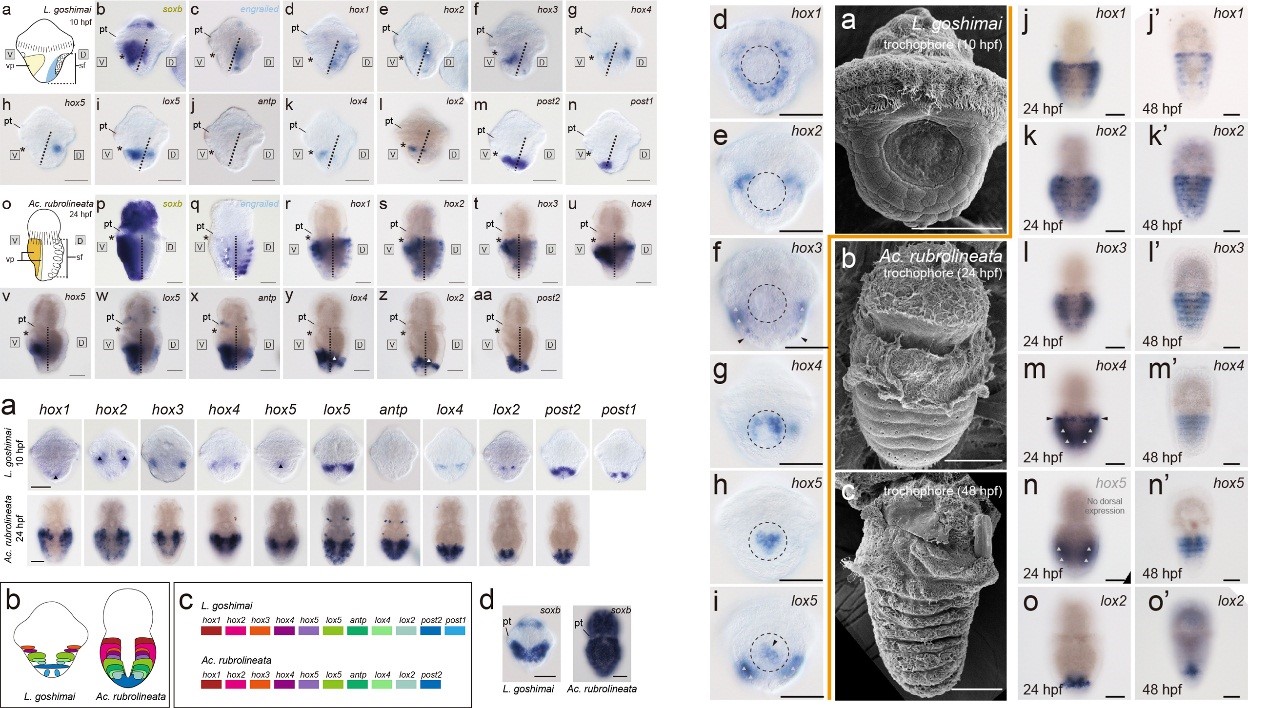Mollusca is the second species-rich phylum among the animals. Moreover, each of the eight molluscan classes shows a distinct body plan, e.g., clams, octopuses, snails and chitons. Compared to other animals such as arthropods or vertebrates, the diversity of body plans in molluscs is exceptionally high, and how mollusks became diversified during evolution remains largely elusive.
Prof. LIU Baozhong from the Institute of Oceanology of the Chinese Academy of Sciences (IOCAS) and his colleagues, Dr. HUAN Pin and Ms. WANG Qian, revealed evidence that Hox genes may underpin the diversification of molluscs. Their findings were published in PNAS.
The expression of Hox genes often shows a staggered pattern along the anterior-posterior axis during development. Such staggered Hox expression pattern is highly conserved among animals, which has been observed in distant animal lineages such as vertebrates, arthropods and annelids. However, the Hox genes of molluscs show very diverse expression patterns, and the staggered patterns are relatively ambiguous in some species. Although generalized models are suggested by several researchers, essential details are required forfurther refinementand to infer the evolutionary implications.
Prof. LIU and colleagues focused on two phylogenetically distant molluscs, a gastropod (the limpet Lottia goshimai) and a polyplacophoran (the chiton Acanthochitona rubrolineata). They collected samples at various developmental stages in a relatively high density (as short as two-hour intervals, which was subsequently proved crucial to reveal hidden interlineage similarities). By comparing the many Hox expression data, they finally concluded that the key characteristic of the Hox expression of the two molluscan species was the decoupling of dorsal and ventral expression.

The animals used in this study
In general, dorsal Hox expression correlated with the shell field (the tissues responsible for the development of shells), which showed lineage-specific characters, and ventral Hox expression was associated with foot development and neurogenesis, which showed interlineage conservation (by showing staggered expression pattern) at particular developmental stages. Such model was then revealed to be compatible to most known Hox expression data reported previously.

Hox expression data of the two species
Based on these findings, Prof. LIU and colleagues proposed a model that may underlie the diversification of molluscs. In this scenario, the dorsoventral decoupling of Hox expression allows lineage-specific dorsal and ventral patterning of different molluscs, which then facilitate the diversification of molluscan body plans.

The model of body plan evolution in molluscs
Lastly, the authors further checked the Hox expression data from other spiralians, which were animal groups phylogenetically close to molluscs. They found that the dorsoventral decoupled model was also compatible to most of the known Hox expression data of other spiralian clades, such as rotifers, nemerteans, brachiopods and even some annelids. This result indicated that the dorsoventral decoupling of Hox expression may underpin the body plan evolution of a broader range of animals, and may contribute to important animal diversification events such as the Cambrian explosion.

Staggered Hox expression only confined to ventral ectoderm in various spiralians
Prof. Liu and colleagues proposes a novel model of molluscan evolution in this study, which provides insights into the mechanisms of animal body plan diversification.
This study was supported by the National Key R&D Program of China, the Marine S&T Fund of Shandong Province for Pilot National Laboratory for Marine Science and Technology (Qingdao), etc.
IOCAS PIO: Ms. YANG Fengfan
Phone: 86-532-82898623
E-mail: fengfanyang@qdio.ac.cn